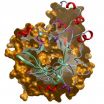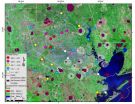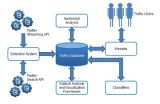(Press-News.org) A study conducted at Copenhagen University Hospital showed that treatment of rheumatoid arthritis (RA) with disease modifying antirheumatic drugs (DMARDs), glucocorticoids, biologic agents, or a combination of agents significantly reduced radiographic evidence of joint destruction, with a relative effect of 48%% as compared with placebo. A direct comparison between the combination of a biologic agent plus methotrexate and the combination of 2 DMARDs plus initial glucocorticoids revealed no difference. Study findings are published in the October issue of Arthritis & Rheumatism, a journal of the American College of Rheumatology.
DMARDs are commonly used to treat RA by slowing the course of the disease. During the last 10 years, several effective, but expensive, immunoselective biologic agents have been introduced for the treatment of RA. Biologic agents are genetically engineered medications that help block the pathways of inflammation. Because of their expense, biologic agents are typically reserved as second-line drugs for patients who are unresponsive to DMARDs. However, in clinical trials, they have been used to treat patients who have not previously taken DMARDs and now some guidelines recommend biologic agents as first-line treatment for selected patients in whom a poor prognosis is suspected.
Radiographic progression is the most important measure of structural damage in RA. One of the claimed breakthroughs of biologic agents is their potential to arrest radiographic progression. The corresponding ability of DMARDs is less well defined because the effect of DMARDs on radiographic progression has only sporadically been investigated in randomized trials. The purpose of the present study was to quantify the effect of approved drugs and treatment methods (DMARDs, glucocorticoids, biologic agents, and combination treatments) on the yearly progression of radiographic joint destruction in patients with RA.
The researchers conducted a meta-analysis of full-length studies published in peer-reviewed journals. A total of 70 trials, including 112 comparisons, were identified. Participants included patients with RA diagnosed according to the criteria of the American College of Rheumatology. A total of 16 interventions and 5 subinterventions were defined in 5 main groups: Group 1 was defined as single DMARD versus single DMARD; Group 2 was defined as single DMARD versus placebo or analog; Group 3 was defined as combination DMARDs versus single DMARD; Group 4 was defined as glucocorticoids with or without a DMARD versus placebo or analog with or without a DMARD; Group 5 was defined as a combination biologic agent plus MTX versus MTX or other DMARDs with or without glucocorticoids.
Analysis revealed that treatment with a single DMARD or glucocorticoids significantly reduced radiographic evidence of joint destruction, with a relative effect of 48%% as compared with placebo and that aggressive combination therapy with 2 DMARDs, a DMARD plus glucocorticoids, or a DMARD plus a biologic agent reduced radiographic joint destruction, with a relative effect of 50%% as compared with single-DMARD therapy. The effect of a combination of 2 DMARDs plus step-down glucocorticoids did not differ from the effect of a biologic agent plus methotrexate.
"This is the first meta-analysis to include all of the antirheumatic drug treatment principles in a single review, including the effects of different combinations of drugs," says study leader Dr. Niels Graudal. He continues, "Our findings remove any previous doubt that may have existed about the efficacy of single-DMARD treatment on radiographic progression in RA. Furthermore, our findings confirm that aggressive treatment with combination DMARDs does reduce structural joint damage as compared with less-aggressive treatment with a single DMARD and that combination DMARD treatment, especially when combined with periodic glucocorticoids, may be as effective as a biologic agent plus MTX. The recommendation that treatment with a DMARD is the first choice for RA is therefore still valid."
INFORMATION:
Article: "Similar Effects of Disease-Modifying Antirheumatic Drugs, Glucocorticoids, and Biologic Agents on Radiographic Progression in Rheumatoid Arthritis: Meta-Analysis of 70 Randomized Placebo-Controlled or Drug-Controlled Studies, Including 112 Comparisons." Niels Graudal and Gesche Jürgens, Arthritis & Rheumatism; Published Online: June 17, 2010 (DOI: 10.1002/art.27592); Print Issue Date: October 2010. http://onlinelibrary.wiley.com/doi/10.1002/art.27592/abstract
This study is published in Arthritis & Rheumatism. Media wishing to receive a PDF of the article may contact healthnews@wiley.com.
Arthritis & Rheumatism is an official journal of the American College of Rheumatology and covers all aspects of inflammatory disease. The American College of Rheumatology (www.rheumatology.org) is the professional organization who share a dedication to healing, preventing disability, and curing the more than 100 types of arthritis and related disabling and sometimes fatal disorders of the joints, muscles, and bones. Members include practicing physicians, research scientists, nurses, physical and occupational therapists, psychologists, and social workers. For details please visit, http://www3.interscience.wiley.com/journal/76509746/home.
About Wiley-Blackwell
Wiley-Blackwell is the international scientific, technical, medical, and scholarly publishing business of John Wiley & Sons, with strengths in every major academic and professional field and partnerships with many of the world's leading societies. Wiley-Blackwell publishes nearly 1,500 peer-reviewed journals and 1,500+ new books annually in print and online, as well as databases, major reference works and laboratory protocols. For more information, please visit www.wileyblackwell.com or our new online platform, Wiley Online Library (wileyonlinelibrary.com), one of the world's most extensive multidisciplinary collections of online resources, covering life, health, social and physical sciences, and humanities.
END
Social rejection isn't just emotionally upsetting; it also upsets your heart. A new study finds that being rejected by another person makes your heart rate drop for a moment. The study is published in Psychological Science, a journal of the Association for Psychological Science.
Research has shown that the brain processes physical and social pain in some of the same regions. Bregtje Gunther Moor, Eveline A. Crone, and Maurits W. van der Molen of the University of Amsterdam and Leiden University in the Netherlands wanted to find out how social pain affects you physically. ...
Results from a 12-month multi-center clinical trial did not show therapeutic benefit of abatacept over placebo in patients with non-life threatening systemic lupus erythematosus (SLE). Abatacept failed to prevent new disease flares in SLE patients tapered from corticosteroids in an analysis where mild, moderate and severe disease flares were evaluated together. Full details of the phase IIb clinical trial are published in the October issue of Arthritis & Rheumatism, a journal of the American College of Rheumatology (ACR).
The ACR estimates that 161,000 to 322,000 adults ...
The Structural Genomics Consortium (SGC), an international public-private partnership that aims to determine three dimensional structures of medically important proteins, announced today the release into the public domain of its 1000th high resolution protein structure.
The 1000th structure – known as JmjD2C – belongs to a class of proteins involved in epigenetic signalling, a key research area for the SGC. Epigenetics is the study of inherited changes in gene expression caused by proteins such as JmjD2C which 'switch' genes on or off. It is believed that a better understanding ...
HOUSTON, Sept. 28, 2010 – A large section of northwestern Harris County – particularly the Jersey Village area – is sinking rapidly, according to a University of Houston (UH) geologist who has analyzed GPS data measuring ground elevation in the Houston area.
Some points in Jersey Village are subsiding by up to 5.5 centimeters (about 2 inches) a year, said Shuhab Khan, an associate professor of geology at UH. Khan, along with UH geology professor Kevin Burke and former Ph.D. student and UH alumnus Richard Engelkemeir, studied a decade's worth of detailed GPS data measuring ...
In comments sent to Secretary Kathleen Sebelius at the U.S. Department of Health and Human Services, AMIA (American Medical Informatics Association) called out 10 specific challenges to proposed modifications to HIPAA Privacy and Enforcement Rules. AMIA's comments, sent on behalf of its membership of 4,000 informatics professionals, detail key issues of concern related to the Notice of Proposed Rulemaking (NPRM) on HIPAA modifications, along with suggestions for models of change. The following areas were cited:
Business Associates and Subcontractors
Position: AMIA ...
Although the magnificent frigatebird may be the least likely animal on the Galapagos Islands to be unique to the area, it turns out the Galapagos population of this tropical seabird may be its own genetically distinct species warranting a new conservation status, according to a paper by researchers at the Smithsonian Conservation Biology Institute, the Smithsonian's National Museum of Natural History and the University of Missouri-St. Louis published last week in the scientific journal Proceedings of the Royal Society B.
The Galapagos Islands, which once served as a scientific ...
When the scientific and spiritual worlds collide, they do so in the most surprising ways. Classical meteorological and plant science has, in the last century, insisted that dew negatively affects plant life, leading to rot and fungus. But in the Judeo-Christian tradition, dew is most welcomed as an important source of vegetative and plant life, celebrated in poetry and prayer.
Now Prof. Pinhas Alpert of Tel Aviv University's Department of Geophysics and Planetary Sciences has developed an explanation for the perplexing paradox with his colleagues. According to scientific ...
A study carried out by Spanish researchers has shown that the presence of chemical contaminants can interact with noise and modify, for good or for bad, the way in which work-related "deafness" – which is increasingly common among young people – manifests itself. Noise-related hearing loss is the most common occupational disease in Europe.
"Workers exposed to noise in the presence of metalworking fluids exhibit a delay in hearing alteration in comparison with those exposed only to noise at the same intensity. However, those exposed to noise in the presence of welding ...
Astroturfers, Twitter-bombers and smear campaigners need beware this election season as a group of leading Indiana University information and computer scientists today unleashed Truthy.indiana.edu, a sophisticated new Twitter-based research tool that combines data mining, social network analysis and crowdsourcing to uncover deceptive tactics and misinformation leading up to the Nov. 2 elections.
Combing through thousands of tweets per hour in search of political keywords, the team based out of IU's School of Informatics and Computing will isolate patterns of interest ...
FORT WORTH, TEXAS, USA, September 28, 2010—The outbreak of whooping cough in Texas, California, and other states this year underscores the critical importance of widespread vaccination coverage, both locally as well as around the world, said a leading global health official attending conferences on world affairs and immunization in Fort Worth this week.
Alex Palacios, a special representative of the GAVI Alliance, a public-private partnership aimed at increasing immunisation rates in poor countries, said that despite public health advances in the US and other wealthy countries ...





